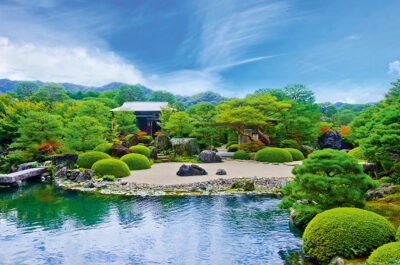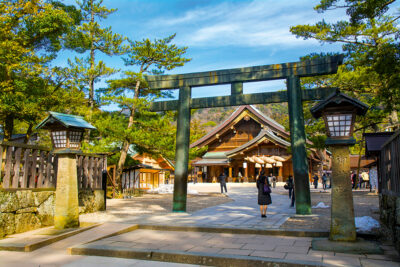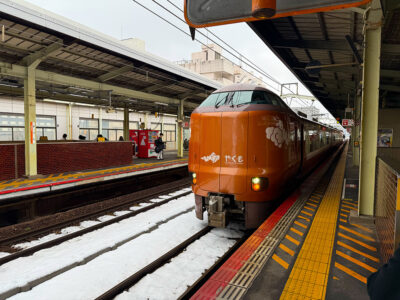
Yakumo, or ‘eight clouds’, is a word that echoes throughout the history of Japan. It’s a poetic allusion to the mists shrouding the ancient province of Izumo, which lies across the Chugoku Mountains from the well-trodden trail between Osaka and Hiroshima. Here you’ll find thousand-year-old shrines and one of Japan’s 12 remaining original castles, as well as an old rail route that has recently been given a new look and a fresh purpose.
Yakumo is also the name given to an express service that dates back more than 50 years. It was updated in 2024 with a new train equipped with panoramic windows, so you can take in the scenery as you wend your way along river valleys and through the mountains in the west of Honshu, from Okayama to the city of Izumo. It is the first of a new breed of limited expresses, created to entice travellers to visit some of the more remote and overlooked corners of Japan.
The name also has important ties to the history of the region. It speaks to a time when Japan was opening up to the world in the late 19th century. Back then, Japonisme, a fascination with Japanese culture and design, was spreading across Europe, and the Greek-Irish writer Lafcadio Hearn was one of the first voices collecting, translating and explaining Japanese history and literature for English-speaking audiences. He would go on to become the first legally naturalised Japanese subject, marrying a local woman and adopting Yakumo as his given name to honour the region that he called “my beloved province”. In the city of Matsue, one of the stops along the Yakumo line, you can even visit Hearn’s former house, now a fascinating museum.
You’ll board the service at Okayama Station, just 50 minutes from Shin-Osaka aboard the JR Sanyo Shinkansen. Inside the Yakumo’s gleaming bronze carriages, daubed with accents of white clouds, is comfortable and spacious seating, whether in the standard car, the two- and four-person semi-compartment boxes, or first class.
The Yakumo runs once an hour from early morning until the evening, and all seats come with power outlets to keep your devices charged. There’s free wifi, so you can follow along on your phone’s map, although you’ll likely be too busy staring out of the window to catch sight of the Fuji-like Mount Daisen. Signs and announcements are in English, so even first-time visitors to Japan should be able to navigate this service with ease.
Highlights from the Yakumo route
Okayama

You’ll start in the friendly, relaxed railway junction city of Okayama. It’s a brilliant base for a few days, with hotels of every budget located at the train station. The Toyoko Inn, an inexpensive chain aimed at the business crowd, has three locations here, with the Nishi-guchi Migi branch overlooking the station and the tracks.
In Okayama, don’t miss the 17th-century Korakuen, one of the three most famous gardens in Japan. It lies opposite the slate-grey Okayama Castle, a modern reconstruction known as ‘crow castle’ for its dark-grey exterior. Inside lies a fascinating museum, and there is also a ceramics studio on the grounds where you can try making Bizen-yaki pottery, a local earthenware known for its reddish-brown colour and tough exterior.
Matsue

The writer Lafcadio Hearn called Matsue ‘the chief city of the province of the gods’. Sat overlooking the Sea of Japan, it is home to a fine example of one of the country’s 12 original castles; all the rest are reconstructions, having either been toppled by earthquakes, wars or simply destroyed once the feudal age came to an end.
Several sightseeing boat tours of the canal district nearby offer a step back into history. Elsewhere, the Lafcadio Hearn Memorial Museum is located in the writer’s former home, north of the castle; to the east is the local Matsue History Museum, which also has a superb tea shop.
Outside town, take a bus from Matsue Station to visit the Yuushien strolling garden on Daikon Island. It is famous for its peonies and is particularly breathtaking in autumn when the trees are burnished red and gold. The Adachi Museum of Art and its elegant garden lie in nearby Yasugi, which is reached via free shuttle buses from the JR station.
Izumo

Most Japanese visitors to Izumo are coming to visit the Izumo Taisha shrine, one of the oldest and most noteworthy in the Shinto religion. Set amid forested hills, it’s an awe-inspiring experience, particularly during the Kamiari Festival in the tenth month of the lunar calendar (usually November). The excellent Shimane Museum of Ancient Izumo is also well worth a visit, but note that it’s closed until September 2026 for renovations.
Izumo Taisha is 30 minutes by bus from the JR Izumoshi railway station. Or take the local Ichibata Electric Railway to the Izumo Taisha-Mae station at the shrine, changing at Kawato station. This follows a scenic line that skirts the shores of Lake Shinji to its eastern terminal, near Matsue Castle.
Nearby rail experiences

From either Izumo or Matsue, you can ride the Sunrise Izumo, one of only two sleeper trains (aside from luxury ‘land cruise’ services) still operating in Japan. It runs to and from Tokyo.
In Okayama, you can hop on the Sanyo Shinkansen, which operates between Osaka and Fukuoka. Heading west, you’ll pass through Kurashiki and Hiroshima; head east for Himeji (home to an original castle), Kobe and Osaka.
Alternatively, take any of the trains heading south from Okayama to the island of Shikoku. Book ahead and pay extra for a seat in the front car of the train; it’s worth it as you cross the Great Seto Bridge. The JR Shikoku Railway Company has several excellent excursion trains that operate on the island.
Lastly, there are many local diesel trains running on lines serving local communities in western Honshu, carving through the mountains and along river valleys. Niimi (one hour by train from Okayama) is a good place to catch these.
Need to know
Booking tickets
While the Japan Rail Pass can be a great deal – even with its recent price hike – a general rule of thumb is that you need to get about 7,200 yen–worth (£38) of daily value from the ordinary seven-day car pass. Okayama to Matsue is just 5,940 yen (£31) one-way, so unless you’re taking the Yakumo as a day trip, consider planning it outside your seven-day Japan Rail Pass window, and save your pass for the more expensive Shinkansen journeys.
Use JR West’s e5489 online reservation system to book your seat, but make sure you note down both the reservation numbers and identification numbers the system gives you. And don’t miss the station souvenir shops, filled with offical Yakumo merchandise such as toys, office supplies and towels.
Read next: Riding The Ghan between Darwin and Adelaide, Australia



















